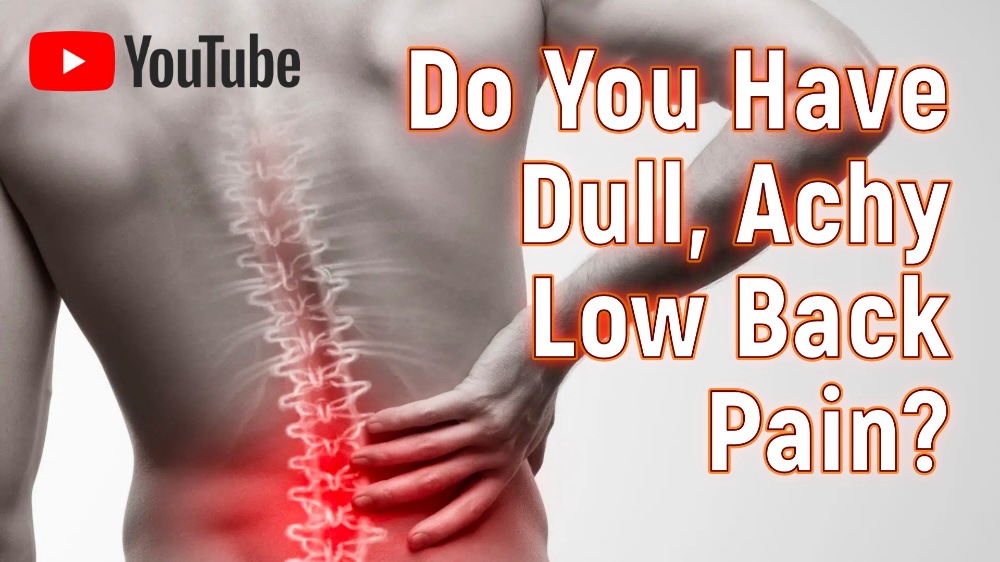Find out about the most common type of mechanical low back pain. Learn about low back pain as a result of facet joint inflammation, limited range of motion, micro-trauma, weight gain, muscle tension, fixation and alignment issues, and how to correct and alleviate Lumbar Facet Syndrome.
00:00 – Introduction to Lumbar Facet Syndrome
01:27 – Symptoms
02:53 – Causes
08:49 – Solutions
Causes/Etiology:
Lumbar Facet Syndrome is a referred pain pattern that arises from the irritation of the lumbar facet joints innervated by spinal nerves of L1-L5. Lumbar facet joint syndrome refers to a dysfunction at the level of the posterior facet joints of the spine due to inflammation, joint restriction, and joint surface degeneration.
- Lack of flexibility in the low back
- Facet imbrication (jamming of facet joints)
- Tight muscles, ligaments, tendons decrease facet joint movement
- Osteoarthritis
- Significant weight gain and protruding abdomen that changes the bodies center of mass
- Change in stress on low back and facet joints
- Hyperlordosis of the lumbar spine that reinforces poor posture
- Left untreated can lead to a fibrosis and bony osteophyte formation
- Most common cause is repetitive microtrauma and a result of this chronic degeneration
- Irritation can also occur when the intervertebral disc is damaged and the biomechanics of the joint have changed. In this case the facet joints are exposed to a higher loading and compressive forces
Common Symptoms:
- Pain is localized in the low back and sacrum
- Pain is characteristically dull and achy
- Can be chronic if not addressed
- Stiffness and limited range of motion
- Pain on Extension (backward bending) – due to facet joint compression
- Pain on initiating movement
- Getting out of chair and standing up
- Moving from a fixed position
- Guarding and Apprehension due to pain on movement
- May cause you to walk in a hunched over position / antalgic / guarding posture
- Relief on Flexion
- Antalgic in certain positions, forward leaning/bending
- Usually non-radiating pain into legs except in extreme cases
- Can be confused with a vertebral disc issue and sciatic pain patterns
Early stages:
- Sudden acute pain in low back may happen several times a year without warning
- Not connected with an injury
- Pain may not last long and seem to go away on its own
- Muscles react to painful movement by “guarding” and become increasingly more tense and strained.
Possible Treatment Options:
- Chiropractic Manipulative Therapy (CMT) and therapeutic Range of Motion mobilization
- Leander Flexion/Distraction Table Treatment
- Diet/Weight loss to restore Lumbar curve and decrease loading on facets
- Core strength and conditioning to decrease hyperlordosis
- Physical Therapy to increase ROM and Strengthen muscles that support lumbar spine
- Stretching and active exercise programs to support other therapies.
- Identify and eliminate Mechanism of Injury if chronic or episodic
- Posture re-education and ergonomic evaluation for both work and home
- Injections & Surgical intervention for extreme cases
Follow us on Social Media:
Instagram: https://www.instagram.com/drlarinde/
Youtube: https://www.youtube.com/@drlarinde
About Dr. Mark Larinde, DC:
Dr. Larinde, a 1996 graduate of Los Angeles College of Chiropractic, specializes in Injury Prevention & Rehabilitation, Nutrition, and works with patients in his office to make a full and long lasting recovery.
Disclaimer:
Dr. Mark Larinde received his Doctor of Chiropractic degree from Los Angles College of Chiropractic in 1996. His use of “doctor” or “Dr.” in relation to himself solely refers to that degree. Dr. Larinde is a licensed chiropractor in California and practices Chiropractic at the Center for Health and Longevity in Santa Monica California. This video is for general informational purposes only and should not be used to self-diagnose and it is not a substitute for a medical exam, cure, treatment, diagnosis, and prescription or recommendation. It does not create a doctor-patient relationship between Dr. Larinde and you. You should not make any change in your health regimen or diet before first consulting a physician and obtaining a medical exam, diagnosis, and recommendation. Always seek the advice of a physician or other qualified health provider with any questions you may have regarding a medical condition.

Dr. Mark Larinde, a ’96 graduate of Los Angeles College of Chiropractic, specializing in Injury Rehabilitation and Prevention works with patients to make a full and long lasting recovery




